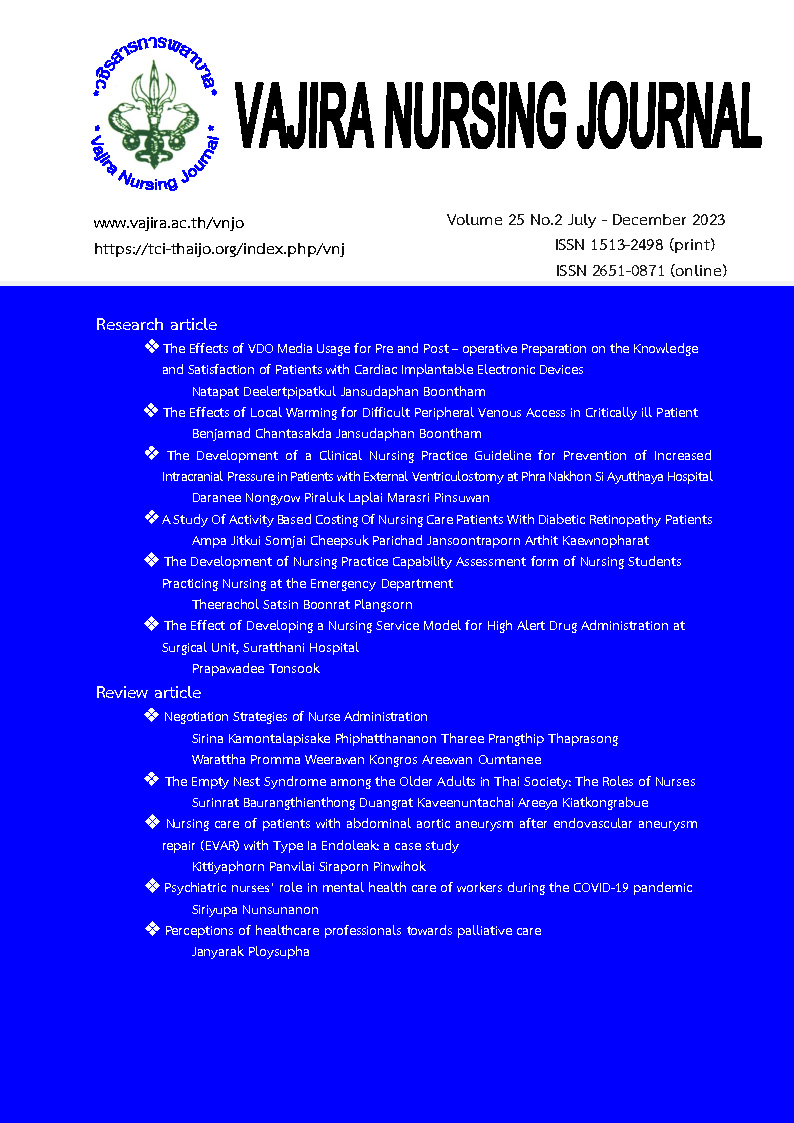การรับรู้ของบุคลากรทางการแพทย์ต่อการดูแลแบบประคับประคอง
Main Article Content
บทคัดย่อ
การดูแลแบบประคับประคองมีการพัฒนาจากปรัชญาบ้านพักรับรองที่ก่อตั้งโดย Cicely Saunders มีเป้าหมายที่จะปรับปรุงคุณภาพชีวิตของผู้ป่วยที่เจ็บป่วยด้วยโรคที่คุกคามชีวิต ตอบสนองตามความต้องการของแต่ละบุคคล โดยการป้องกันและบรรเทาความทุกข์ทรมาน ทางด้านร่างกาย จิตใจ ตอบสนองความต้องการด้านจิตวิญญาณ และให้การดูแลช่วยเหลือครอบครัวของผู้ป่วย ปัจจุบันย่างเข้าสู่สังคมผู้สูงอายุโดยสมบูรณ์ การดำรงชีวิตส่งผลต่อแบบแผนการดูแลภาวะสุขภาพ โดยเฉพาะอย่างยิ่งก่อให้เกิดความเจ็บป่วยด้วยโรคเรื้อรังที่ส่งผลกระทบต่อระบบสุขภาพโดยรวม สะท้อนให้เห็นถึงความต้องการการดูแล
แบบประคับประคองที่เพิ่มขึ้น บุคลากรทางการแพทย์จึงมีบทบาทสำคัญ ต้องมีสมรรถนะด้านความรู้ ทักษะความสามารถ และเจตคติในการดูแลแบบประคับประคอง ซึ่งบทความนี้จัดทำขึ้นโดยมีวัตถุประสงค์เพื่อศึกษาความสำคัญของการดูแลแบบประคับประคองและการรับรู้ของบุคลากรทางการแพทย์ต่อการดูแลแบบประคับประคอง
ผลการศึกษาความสำคัญของการดูแลแบบประคับประคองประกอบด้วย การสนับสนุนจิตใจและอารมณ์ การปรับปรุงคุณภาพชีวิต การดูแลแบบองค์รวม การจัดการอาการ การสนับสนุนครอบครัว การดูแลอย่างต่อเนื่อง และการเคารพในความต้องการของผู้ป่วย
ผลการศึกษาการรับรู้ของบุคลากรทางการแพทย์ พบว่า บุคลากรทางการแพทย์ต้องมีความรู้ และทำความเข้าใจเกี่ยวกับศาสตร์ของการดูแลแบบประคับประคองในประเด็นต่อไปนี้ ได้แก่ หลักปรัชญาการดูแลแบบประคับประคอง การทำงานเป็นทีมสหวิทยาการ ทักษะการสื่อสาร การวางแผนการดูแลล่วงหน้าหลักจริยธรรมและวัฒนธรรม รวมถึงการดูแลในระยะท้าย การศึกษาและการฝึกอบรม
Article Details

อนุญาตภายใต้เงื่อนไข Creative Commons Attribution-NonCommercial-NoDerivatives 4.0 International License.
เนื้อหาและข้อมูลในบทความที่ลงตีพิมพ์ในวชิรสารการพยาบาลถือเป็นข้อคิดเห็นและความรับผิดชอบของผู้เขียนบทความโดยตรง ซึ่งกองบรรณาธิการไม่จำเป็นต้องเห็นด้วย หรือร่วมรับผิดชอบใด ๆ ทั้งสิ้น
บทความ ข้อมูล เนื้อหา รูปภาพ ฯลฯ ที่ได้รับการตีพิมพ์ในวชิรสารการพยาบาล ถือเป็นลิขสิทธิ์ของวชิรสารการพยาบาล หากบุคคลใดหรือหน่วยงานใดต้องการนำทั้งหมดหรือส่วนหนึ่งส่วนใดไปเผยแพร่ต่อหรือเพื่อกระทำการใด ๆ จะต้องได้รับอนุญาตเป็นลายลักอักษรจากวชิรสารการพยาบาลก่อนเท่านั้น
เอกสารอ้างอิง
Cherny, N. I., & Radbruch, L. European Association for Palliative Care (EAPC) recommended framework for the use of sedation in palliative care. Palliative medicine, 2009. 23(7), 581-593.
World Health Organization. Global Health Observatory. 2019. http://www.who.int/ gho/en/ (access September 16, 2019).
Tangcharoensathien, V, P Prakongsai, S Lim-wattananon, W Patcharanarumol, P Jongudomsuk. From Targeting to Universality: Lessons from the Health System in Thailand. In Peter Townsend, ed. Building Decent Societies: Rethinking the Role of Social Security in Development. Hampshire: Palgrave Macmillan, 2009. 310-22.
World Health Organization. Why palliative care is an essential function of primary health care, 2018). (No. WHO/HIS/ SDS/2018.39). World Health Organization.
สำนักงานคณะกรรมการสุขภาพแห่งชาติ. สิทธิและหน้าที่ด้านสุขภาพ มาตรา 12, 2561. https://www.nationalhealth.or.th/th/rights/Article_12
กองยุทธศาสตร์และแผนงาน สำนักงานปลัดกระทรวงสาธารณสุข. แผนพัฒนาระบบบริการสุขภาพ, 2561. https://spd.moph.go.th
มลิวัลย์ แจ่มแจ้ง. การพัฒนาบทบาทของเภสัชกรในการดูแลผู้ป่วยมะเร็งแบบประคับประคอง ร่วมกับทีมสหสาขาวิชาชีพของโรงพยาบาลสระบุรี. วารสารเภสัชกรรมคลินิก, 2566, 29(2), 103-115.
Van Mechelen, W., Aertgeerts, B., De Ceulaer, K., Thoonsen, B., Vermandere, M., Warmenhoven, F., De Lepeleire, J. Defining the palliative care patient: a systematic review. Palliative Medicine, 2013ม 27(3), 197-208.
George, L. K. Research design in end-of-life research: state of science. The gerontologist, 2002, 42(3), 86-98.
Rego, F., Pereira, C., Rego, G., Nunes, R. The psychological and spiritual dimensions of palliative care: A descriptive systematic review. Neuropsychiatry, 2018, 8(2), 484-494.
Wilkie, D. J., Ezenwa, M. O. Pain and symptom management in palliative care and at end of life. Nursing outlook, 2012, 60(6), 357-364.
Connor, S. R. Hospice and palliative care: The essential guide (2nded.)New York: Taylor and Francis, 2009.
Wilkinson, S., Bailey, K., Aldridge, J., Roberts, A. A longitudinal evaluation of a communication skills programme. Palliative Medicine, 1999, 13(4), 341-348.
Gillan, P. C., van der Riet, P. J., Jeong, S. End of life care education, past and present: A review of the literature. Nurse Education Today, 2014, 34(3), 331-342.
Morrison, R. S., Penrod, J. D., Cassel, J. B., Caust-Ellenbogen, M., Litke, A., Spragens, L. Palliative Care Leadership Centers' Outcomes Group. Cost savings associated with US hospital palliative care consultation programs. Archives of internal medicine, 2008, 168(16), 1783-1790.
May, P., Normand, C., Cassel, J. B., Del Fabbro, E., Fine, R. L., Menz, R., Morrison, R. S. Economics of palliative care for hospitalized adults with serious illness: a meta-analysis. JAMA internal medicine, 2018, 178(6), 820-829.
Cassel, B., Garrido, M., May, P., Del Fabbro, E., Noreika, D.Impact of Specialist Palliative Care on Re-Admissions: A “Competing Risks” Analysis to Take Mortality into Account (TH341A). Journal of Pain and Symptom Management, 2018, 55(2), 581.
Lustbader, D., Mudra, M., Romano, C., Lukoski, E., Chang, A., Mittelberger, J., Cooper, D. The impact of a home-based palliative care program in an accountable care organization. Journal of palliative medicine, 2017, 20(1), 23-28.


